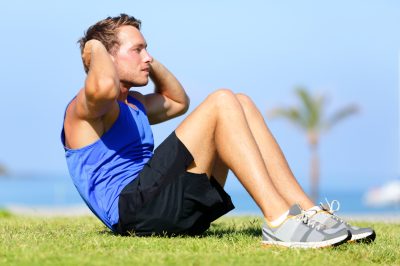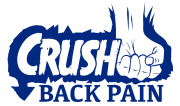To understand what herniated disc exercises to avoid it’s important to understand what causes lumbar discs to herniate
When the general principles that cause lumbar disc herniation are understood a person is able to recognize exercises that should be avoided. If these fundamentals are appreciated, exercises can be modified so they do not have to be avoided altogether.
How discs herniate
Lumbar discs herniated with repetitive flexion, flexion under load, sustained end-range lumbar flexion, and when flexion and rotation (twisting) are combined.
Any exercise that involves repetitive lumbar flexion, end-range lumbar flexion under load, or lumbar flexion with twisting of the trunk should be avoided.
What exacerbates herniated discs
The same exact movements that cause a disc to herniate exacerbate herniated disc related pain. These are the exercises and movements that need to be avoided with a symptomatic herniated disc.
Movements That Exacerbate Herniated Discs
- repetitive lumbar flexion
- flexion under load
- sustained end-range lumbar flexion
- flexion combined with rotation (twisting)
Sitting can also exacerbate herniated discs
Especially if the lower back is allowed to flex excessively in the seated position.
Sitting and flexion can be more detrimental early in the morning. This is because the disc has more fluid and pressure in it right after waking up. While asleep and unloaded the discs take on fluid. Seated positions and flexing the lower back while the fluid content is greatest places more tensile load through the posterolateral disc, where herniations occur.
Simply avoiding early morning lumbar flexion has been proven to decrease lower back pain.
Herniated disc exercises to avoid
Exercises that involve repetitive lumbar flexion, end-range lumbar flexion, compression combined with flexion, flexion combined with rotation, and repetitive flexion/extension should all be avoided with a symptomatic herniated disc.
Herniated Disc Exercises to Avoid
These exercises involve repetitive lumbar flexion, flexion combined with twisting, and flexion/extension
- sit ups
- seated abdominal crunch
- kneeling cable crunch
- leg press
- hanging knee raise
- hanging toes to bar
- hanging oblique crunch
- GHR or roman chair with flexion/extension through back
- sit up with twist
The list outlines examples of exercises that can exacerbate herniated discs due to repetitive flexion, sustained flexion, flexion under load, and flexion combined with rotation (twisting). This list is by no means exhaustive.

It may be possible to get away with doing some of these exercises again, once the disc is no longer painful. That said, it’s especially important to maintain a neutral lumbar spine during any of these exercises if they’re going to be done.
Keeping the lumbar spine neutral simply means it is not flexing or extending to end-range. It’s kept in between flexion and extension, in “neutral.”
How to make any exercise disc friendly
Understanding basic principles that compromise discs along with the principles that protect discs allow a person to make most exercises disc friendly.
FAQs
Avoid exercises that involve repetitive lumbar flexion, end-range lumbar flexion, and exercises that combine flexion with rotation (twisting) of the trunk. Exercises that flex and rotate the lumbar spine increase the compression and stress/strain through the disc. This can increase disc herniations, increase symptoms, and prevent healing.
Exercises that involve lumbar flexion and flexion combined with rotation (twisting) should be avoided. Lumbar flexion increases compression through the disc and tensile stress through the posterior disc, where herniations occur. Flexion and rotation combined result in significant strain on the annulus fibrosus, the outer part of the disc. Exercises that involve flexion and flexion/rotation combined have the potential to exacerbate herniated discs.
Following surgery for a herniated disc exercises that flex the lower back and combine flexion with rotation should be avoided. The best exercises to focus on involve maintaining a neutral lumbar spine, while engaging the trunk muscles.
REFERENCES
Balkovec C, McGill S. Extent of nucleus pulposus migration in the annulus of porcine intervertebral discs exposed to cyclic flexion only versus cyclic flexion and extension. Clin Biomech (Bristol, Avon). 2012 Oct;27(8):766-70. doi: 10.1016/j.clinbiomech.2012.05.006. Epub 2012 Jun 5. PMID: 22672744.
Marshall LW, McGill SM. The role of axial torque in disc herniation. Clin Biomech (Bristol, Avon). 2010 Jan;25(1):6-9. doi: 10.1016/j.clinbiomech.2009.09.003. PMID: 19815318.
Tampier C, Drake JD, Callaghan JP, McGill SM. Progressive disc herniation: an investigation of the mechanism using radiologic, histochemical, and microscopic dissection techniques on a porcine model. Spine (Phila Pa 1976). 2007 Dec 1;32(25):2869-74. doi: 10.1097/BRS.0b013e31815b64f5. PMID: 18246010.



